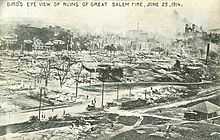Great Salem Fire of 1914

The Great Salem Fire of June 25, 1914, destroyed 1,376 buildings in Salem, Massachusetts.
Before the fire

Franklin H. Wentworth agitated for more fire protection. In an article in the Salem Evening News (March 29, 1910, page 7), he called "Salem in Danger of Destruction by Fire". He felt that the main fire danger was to the downtown business district. The article included a map of all downtown buildings and their type of construction (brick, wood, etc.). Mr. Wentworth, a Salem Councilman, introduced an order that would have required all new or replacement roof coverings to be non-combustible. He argued that this was as important as buying new engines or hiring new firemen. After a big fire, many of the working class would have to live in tents, he warned. Wentworth was accused of serving only the interest of the insurance industry, and the amendment did not pass. Wentworth later became secretary of the National Board of Fire Underwriters.
Another failed attempt to increase safety in Salem was undertaken by Charles J. Collins. He had visited Philadelphia where high-pressure wagons pumped water through 3.25 inches (8.3 cm) pipes for a range of 360 feet (110 m). The argument went that high-pressure pumps would pay for themselves with the reduction of insurance fees. Protecting the entire business and mercantile district would have cost US$150,000.
In 1914, Salem was a city of 48,000 people (12,000 more than ten years earlier) and 5,826 buildings on 5,100 acres (21 km2; 8.0 sq mi) and an assessed valuation of US$37.25 million. The streets were 20 to 140 feet (6.1 to 42.7 m) wide. Building codes were dated and did not mention standpipes, fire escapes, or sprinklers.
Salem had 180 fire alarm stations or boxes that could be used to contact telephone operators.
A long drought preceded the events of June 25, 1914.
The fire
The Great Salem Fire started with a series of explosions, caused by a mixture of acetone, amalacitate, alcohol, and celluloid. At 1:37 PM, a fire alarm box was used to report a fire in the Korn leather factory, 57 Boston street.
The fire spread quickly down and across Boston Street. The police department sent out calls to 21 cities for assistance. One industrial department, the Fore River Shipyard, also assisted. Over 90 police men from out of town came to help. The Salem Evening News, (Friday, July 26, 1914, page 11), has a complete list of all responding departments and where and how they worked to fight the fire. The Salem Evening News covered the events in a series of articles which were later reprinted as a book by Montanye Perry.[1]
Aftermath
The fire burned 253 acres (1.02 km2; 0.395 sq mi) with 1,376 buildings. The entire loss was estimated at US$15 million; insurance policies paid US$11.744 million. Some 20,000 people lost their homes, 10,000 their jobs, and a few their lives.
Chestnut Street designed by Samuel McIntire survived the great Salem fire as did what is now the Salem City Hall, the oldest continually run city hall in America, opened in 1837. The McIntire Historic District is the largest area of homes in America that date from the 1642 to 1865.
| Historical value | Adjusted for inflation | |
|---|---|---|
| Assessed valuation of Salem prior to fire | $37.25 million | $877 million |
| Damage | $15 million | $353 million |
| Covered by insurance | $11.744 million | $277 million |
| Equipping the entire business and mercantile district with high pressure pumps |
$150,000 | $3.53 million |

Folklore
According to legend, Giles Corey's ghost appears the night before a catastrophe in Salem. Some even say that the old man who was seen in a graveyard before the Great Salem Fire was Giles Corey.
References
- ↑ Perry, Montanye (1915). The Salem Fire Relief. Reprint of a Serial published in the Salem Evening News, Salem, MA, Milo A. Newhall, Printers.
- ↑ Consumer Price Index (estimate) 1800–2014. Federal Reserve Bank of Minneapolis. Retrieved February 27, 2014.
- Jones, Arthur B. (1914). The Salem Fire. Online version. Accessed on May 28, 2005.
- Sanborn Map Co. Map of Salem Showing Area Destroyed by Fire June 25, 1914.
Coordinates: 42°31′7.07″N 70°54′33.68″W / 42.5186306°N 70.9093556°W